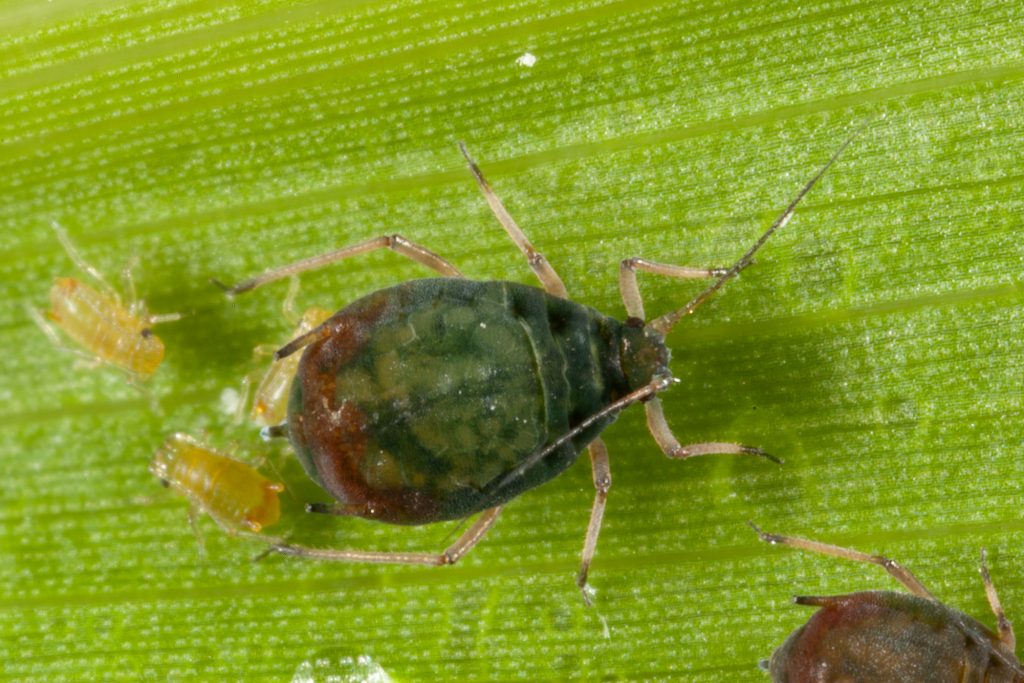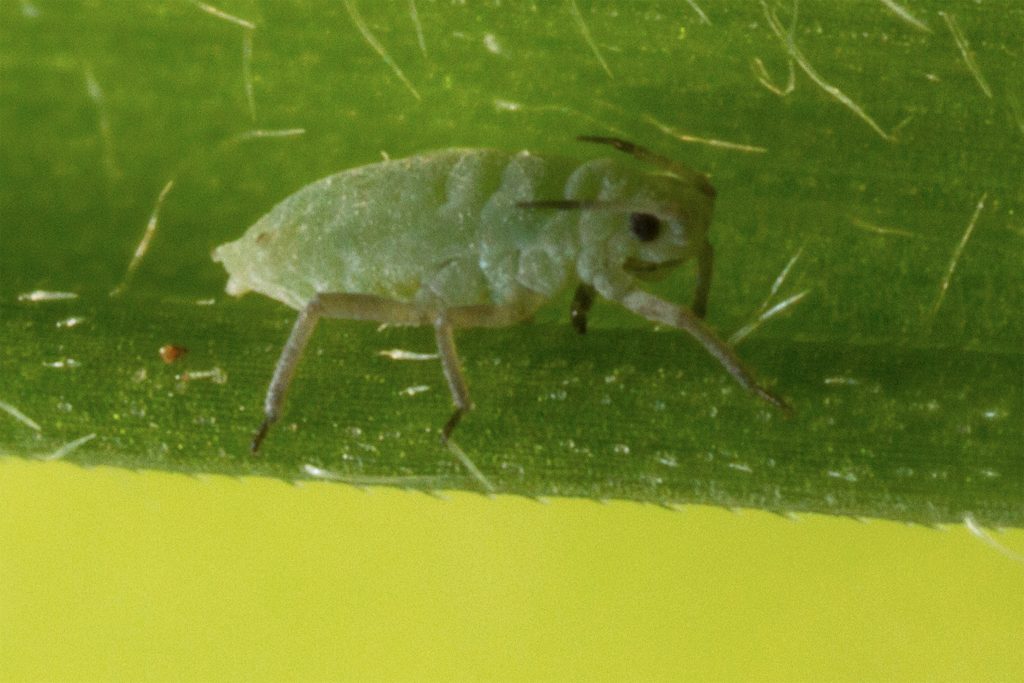Russian wheat aphid has been observed throughout NSW and in some north-western VIC grains crops, with non-seed treated crops more susceptible to infestation.
In this article, we’ll cover where these aphids have been reported, what damage by Russian wheat aphid can look like, the GRDC’s FITE strategy and using the threshold calculator to manage this pest.
Russian wheat aphid reports in Victoria and NSW
We have been receiving reports of Russian wheat aphid (Diuraphis noxia) this past month in central and southern NSW, as well as in wheat crops in the north west of Victoria.
The report coming from Victoria was observed in a non-seed treated wheat crop and was quite prevalent, with damage closely approaching threshold levels just last week.
Russian wheat aphids were also spotted in a paddock of barley in the central south of NSW. No obvious damage was observed in the crop, currently at the tillering stage.
Paddocks of early sown wheat in central NSW at the late tillering stage had signs of the chlorotic streaking characteristic of Russian wheat aphid damage. Samples from those crops which were sent into Cesar found that 20% of the sample size was composed of Russian wheat aphid, with the remaining 80% composed of oat aphid and pea aphid. This is a good reminder that seeing the damage from one type of aphids might not tell the full story of what is happening in the crop.
Russian wheat aphid has reportedly been persisting in earlier sown cereal varieties in central NSW. With the warmer weather approaching and the wind likely to be conducive to aphid flights, it’s important to keep monitoring your paddocks.
The GRDC’s FITE Strategy
In line with the GRDC’s Russian wheat aphid fact sheet, the FITE strategy is recommended for the control of this pest. What does this acronym stand for?
Find: Monitor for aphids and the characteristic plant symptoms of infection. Look for leaf streaking or leaf rolling on cereal crops and grasses.
Identify: Positively identify Russian wheat aphid by consulting with an industry specialist. Sending a report to PestFacts south-eastern counts!
Threshold approach: Consider thresholds for control, the presence of predators and beneficials in the crop, crop growth stages and potential yield losses before deciding on a plan of attack.
Enact: Encourage beneficial insects before implementing chemical control options. Take appropriate actions.
What the F in FITE means, and how to ID the Russian wheat aphid
Russian wheat aphids are generally small in size, green in colour, have a spindle shaped body and their antennae and siphunculi (think ‘exhaust’ pipes) are distinctly short. Wingless adults tend to be lighter in colour, and winged adults darker, both with fine dustings of whiteish or dusky wax.
For in-depth identification information, please watch our PestBites video for a closer look at this pest.
As with any aphid, the crop host often provides the biggest clue as to what species you have on your hands, despite many aphid species being polyphagous. As their name suggests, the Russian wheat aphid prefers wheat crops, however has also been known to survive and reproduce on a wider range of winter cereals.
Other common cereal aphids include oat aphids, corn aphids, and rose-grain aphids.
Oat aphids can be distinguished by the rusty patches at the base of their abdomens and their pear shaped bodies. Corn aphids are oblong and appear darker in colour, with black antennae, cauda and ‘exhaust’ pipes.

Photo by Andrew Weeks, Cesar Australia

Photo by Andrew Weeks, Cesar Australia

Photo by Andrew Weeks, Cesar Australia

Photo by Andrew Weeks, Cesar Australia
Rose-grain aphids appear the most similar to the Russian wheat aphid, though rose-grain aphids have a darker green line down their backs, with larger ‘exhaust’ pipes, and long antennae. In comparison, the Russian wheat aphid is uniform in colour, can appear to be lacking visible ‘exhaust’ pipes to the naked eye, and has very short antennae.
Cereal crops impacted by Russian wheat aphid exhibit white or purple leaf streaking caused when it injects its salivary toxins during feeding. During late stem elongation and tillering, plants may appear flat and leaves may have a tendency to roll. However, the streaking can remain even after Russian wheat aphid are no longer present (e.g. have been cleaned up by beneficial wasps).

Put the T in FITE – a threshold calculator for your toolkit
Developed in 2020 by Cesar Australia and SARDI thanks to investment by the GRDC, the Russian wheat aphid threshold calculator is a decision aid tool to explore whether or not spraying is economically justified.
Making data driven choices regarding the chemical control of crop pests is integral in reducing unnecessary pesticide use, as well as sparing the cost of control if appropriate.
The GRDC has compiled this thorough explanation of how predictive modelling was applied for this tool, as well as the instructions for use of the tool. A summary of what data you’ll need and how to use the calculator can be found in this article here.
The action threshold calculator has been evaluated since its release, and has been found to be accurate in predicting yield loss under the south-eastern grains region’s conditions as well as the western region’s conditions.
Enacting control measures
Before opting for chemical control options, consider encouraging beneficial insects – even if populations have not built up enough to independently suppress the Russian wheat aphid this season, by next season they might keep this pest in check.
This video tackles how IPM works for Russian wheat aphid control, and stresses the importance of managing your green bridges to make next season just that little bit easier.
If the action threshold calculator indicates that your Russian wheat aphid populations have indeed surpassed the threshold that makes control economical and you require chemical control, consider consulting the beneficials chemical toxicity table to inform your decision on which active you would like to employ.
Report aphid pests in your crops
If you spot Russian wheat aphid in southern NSW & Victorian cereal crops, please send a report through. We may even request to come and take a sample.
Get in touch by:
- Texting or calling us on 0484 310 697
- Sending an email to pestfacts@cesaraustralia.com
- Tweeting us @cesaraustralia
Acknowledgements
Thanks to Matt Burkitt (Nutrien Ag), Kirrily Condon (Grassroots Agronomy) Emma Ayliffe (Summit Ag), and Barry Haskins and Luke Schulz (AgGrow Agronomy) for providing field reports.
Resources
For further information and resources, please see the GRDC’s webpage on the Russian wheat aphid.
Cover image: Photo by SARDI





